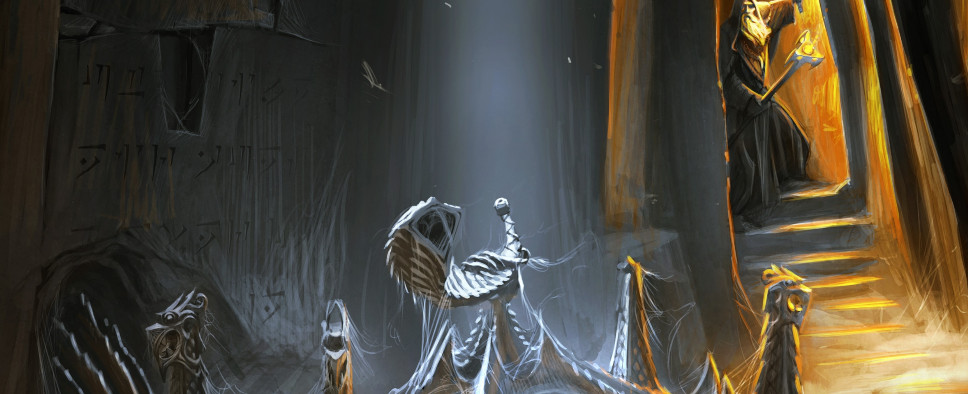On the Secret Smallness of Skyrim
-
Category: News ArchiveHits: 2896

This Eurogamer article talks about how open-world games, and Bethesda's The Elder Scrolls V: Skirym in particular, through their clever use of geometry, level design, and atmosphere manage to seem much larger than they actually are. There are also a couple of paragraphs that bemoan Skyrim's annoying NPCs and I'm not quite sure what that's all about or how it ties into the article, but overall it's a nice read. Check it out:
Skyrim's dirty little secret is that it isn't that large. Oh, it remains fairly gigantic by the standards of other virtual landscapes, even next to its youthful imitator and usurper, The Legend of Zelda: Breath of the Wild. But set against what it pretends to be - a kingdom stretching from arctic wastes to the temperate south, racked by dynastic squabbles and laced with the treasures and detritus of millennia - it's actually pretty dang tiddly, a little over 14 square miles in scope.
14 square miles? That's no bygone, mystery-shadowed dominion rearing its shrines and watchtowers amid sunflashed snow. That's a jumped-up theme park, a country music festival. More to the point, that's approximately the same size as The Elder Scrolls 4: Oblivion, a game which has become something of a punching bag for Elder Scrolls aficionados in hindsight - neither as grand as its swaggering barbarian brother, nor as memorably odd as burned-out hippy uncle Morrowind. Steer clear of distractions like temperamental mammoth herds and you can walk from one side of Skyrim to the other in half an hour.
I'm being quite obtuse, of course. If open world games were required to be as large as their inspirations or narrative aspirations they'd never get finished, and in any case, who would have the time to play them? The fascinating thing about open world design is that it's not really about size at all. It's more the art of the deceptive miniature - of making the poky or digestible seem enormous to the point of exhausting, even as distant cities reveal themselves for neighbouring hamlets, fearsome mountains for mere well-appointed foothills. Skyrim is extremely good at this, to a degree I'm not sure any game environment can rival save the corkscrew terrain of the original Dark Souls. It launches on Switch this week, glory of glories, and I've spent a few hours with the remastered PC version to remind myself of its achievements.
A few months ago there was a great Twitter thread about Breath of the Wild's use of triangular and rectangular silhouettes to rouse and thwart curiosity, layering up the geology and architecture to create tacit routes and kindling suspense around remote landmarks. You can trace much of that to Skyrim, whose mountain ranges are invaluable not just for their particular majesty or the traps and catacombs they house, but for how they rend and twist the map, occluding, exposing and magnifying in a way Oblivion never managed.
Having thrown together a new character, I cheerfully turned my back on starting town Riverwood and embarked on a tour of the major cities, from southern Falkreath to the ancient dwarf fortress of Markarth and up to Skyrim's clifftop capital, Solitude, then across the coast to the Mage's College of Winterhold and down to Windhelm, seat of the Stormcloak rebellion. The roads between settlements aren't long nor especially hard to follow, but goodness me, how long they feel, as each turn, dip or rise unveils some gloomy immensity that vanishes from sight just as swiftly. To walk this kingdom is to weather a perpetual play of horizons and distances, your attention moving irresistibly from near to far and back again. There's that beautiful moment when you spy Winterhold peeking over the shoulder of a range, tempting you to leave the path (and risk being set upon by wolves) in hopes of an uninterrupted view. There's the mild uncertainty as to whether a hazy, barbed shadow is another peak, or the exploded ribcage of an old Nord temple, and the delight of cresting a rise to find a watermill churning peacefully at the bottom of a valley.
Part of the thrill is that the landscape strays just close enough to a naturalistic portrayal that such vistas feel unforced, a compromise between geological process and the designer looking to ensure that threats, havens and opportunities are equally spaced. Passages between holds are credibly the result of rivers eating through the burst edges of folded continental plates. Near Falkreath, hard-wearing boulders wallow in coarse soil, possibly carried there by long-melted glaciers, their lips hung with roots and tiny alpine flowers. There's a caldera above Riften, an enormous basin formed by magma where you'll find poachers (and occasionally, dragons) basking in the heat from volcanic springs. There are those farcical yet somehow convincing transitions between climate zones, as the oppressive drizzle of the estuary beneath Solitude clears and hardens into stark midwinter on the way to Dawnstar - graceful shifts that sell the illusion of travelling hundreds of miles in a few short steps.

